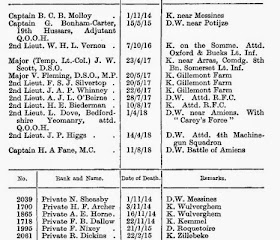The Queen's Own Oxfordshire Hussars continued with its existing numbering sequence when it was formed in April 1908, most of the men joining that year being former Imperial Yeoman.
By August 1914 the regiment formed part of the 2nd South Midland Brigade which was administered from Oxford. Its own headquarters was also at Oxford with its four squadrons disposed as follows:
A Squadron: Oxford
B Squadron: Woodstock
C Squadron: Henley-on-Thames
D Squadron: Banbury
1276 joined on 26th may 1908
1441 joined on 18th February 1909
1552 joined on 8th February 1910
1641 joined on 7th February 1911
1748 joined on 6th March 1912
1838 joined on 8th April 1913
1864 joined on 22nd January 1914
1955 joined on 7th August 1914
2019 joined on 3rd September 1914
2269 joined on 10th October 1914
2306 joined on 2nd November 1914
2385 joined on 5th December 1914
Two reserve units, the 2/1st and 3/1st, were formed during the First World War and both drew their numbers from the same series above.
This from the Naval & Military Press:
"The Oxford Hussars originated as the Oxfordshire Yeomanry, a unit raised in the Napoleonic Wars. By 1914, the unit formed part of the territorial army and were immediately mobilized on the outbreak of the Great War. The regiment saw early service in the autumn of 1914 in the doomed attempts to save Dunkirk and Antwerp from the German advance, and then fell into the routing of trench warfare, holding the line at Messines, just south of the Ypres salient. After experiencing a German gas attack in the second battle of Ypres in April 1915, which they warded off with primitive respirators, the unit continued to serve in the salient, seeing action at St Julien and Bellewaarde Wood, and later at Vermelles. Aftyer years of frustration caused by the paralysis of trench warfare the Hussars came into their own again with the resumption of the war of movement at the end of the war in 1918. This is an exceptionally lively history, full of character sketches of notable members of the regiment and gives a clear picture of the role of a British cavalry unit in and out of the trenches. Illustrated with 27 photographs and 13 maps."
Note that Appendix A of this regimental history provides useful information on the regiment's fatalities, often giving location of death not recorded elsewhere:
I also offer a comprehensive, fast and cost-effective military history research service. Follow the link for more information.



No comments:
Post a Comment
PLEASE READ THIS BEFORE COMMENTING. Thank you for visiting this blog. I welcome insights about regimental numbering but I do not have time to respond to individual research queries here. If you want me to undertake paid research, please follow the instructions on the RESEARCH tab.